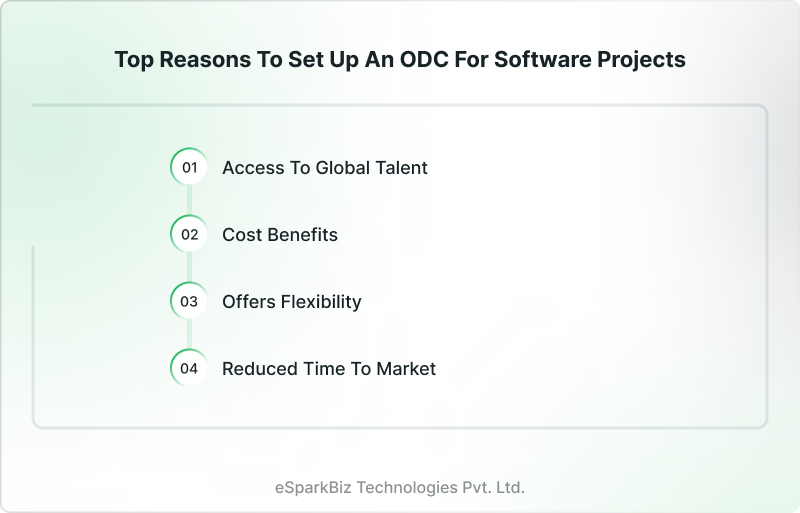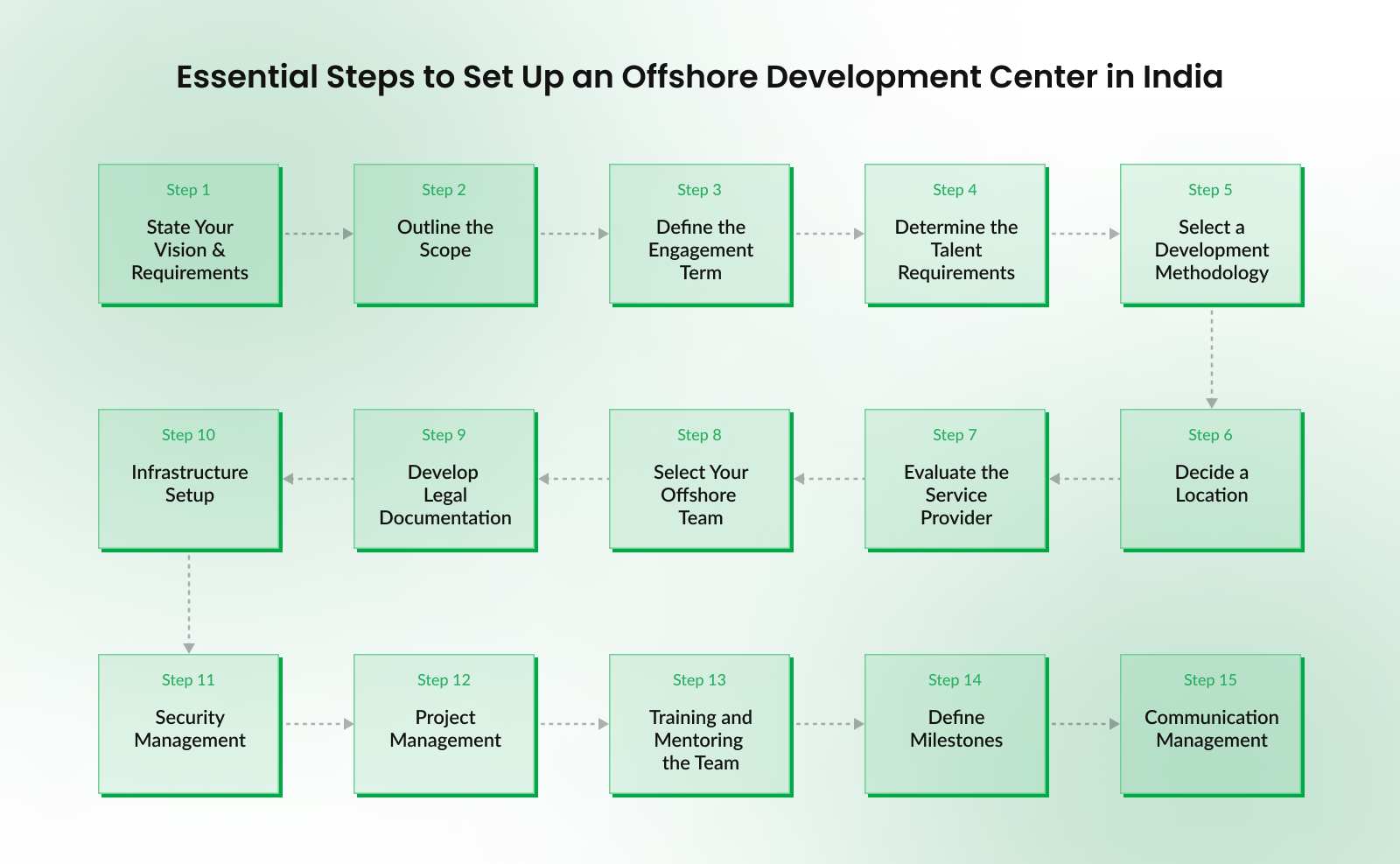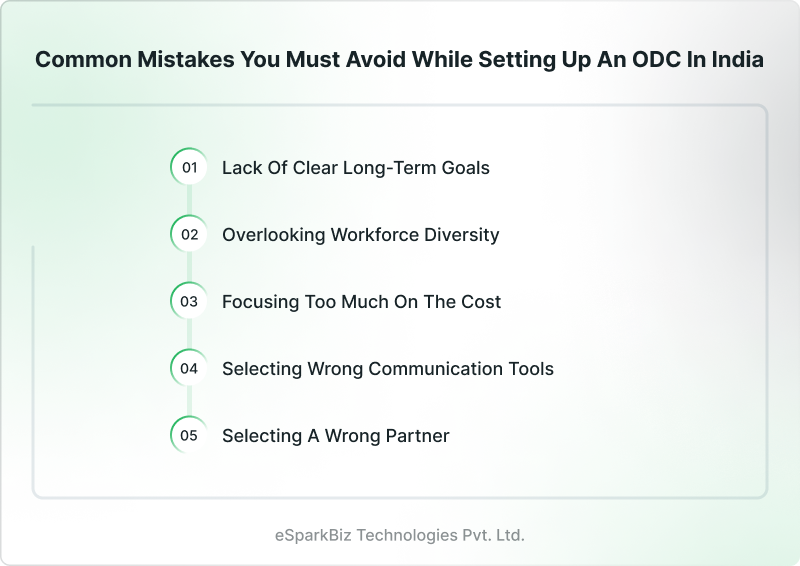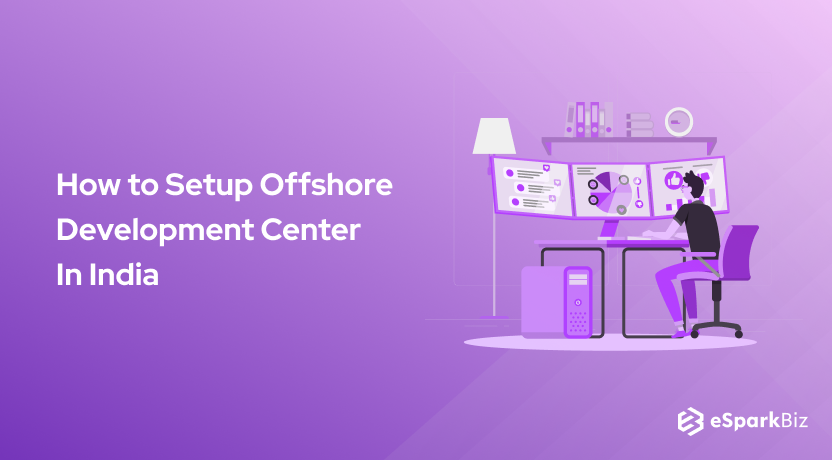The skill gap is widening across the globe. Moreover, the global economic turmoil has become a matter of concern. As a result, more and more companies choose to outsource their software development.
With the growing demand for outsourcing solutions, setting up offshore development centers has become the need of the hour. Did you know that nearly 59 percent of companies choose to outsource to India? Yes, you read it right!
The IT outsourcing market in India is likely to reach USD 20.09 billion by 2028. Besides the US, Canada, Australia, and the UK also outsource their development needs to India.

Therefore, setting up an offshore development center in India has become more vital than ever before. However, the question is how to set up one successfully.
In this article, you will delve into the steps to set up an offshore development center in India. Let’s get started!
Top Reasons to Set Up an ODC for Software Projects
Are you wondering why to set up an offshore development center in India? Well, there are several reasons for that.

In the present era, the business world keeps evolving at an unprecedented pace. To keep up with the market and stay ahead, upgrading your business processes, systems, and technologies is vital.
Before going to the reasons, let’s explore the convincing stats that support the setting up of an offshore development center in India.
- The USA outsources nearly 300,000 jobs every year.
- 50 percent of Fortune 500 companies rely on offshore outsourcing partners for their development needs.
- 45 percent of companies are planning to increase their outsourcing in the near future.
- 25 percent of small businesses choose to outsource their operations in order to achieve optimum efficiency.
Now that you are well aware of the stats, let’s move to the key reasons.
Access to Global Talent
Building an offshore development center can give you an opportunity to gain access to a global talent pool. You can easily augment your IT team with skilled professionals having specialized knowledge and experience in the domain. Moreover, it can also offer you a chance to enter new geographies and expand your business successfully.
Cost Benefits
By setting up an ODC in India, companies can save about 70 percent more compared to in-house hiring. In addition to that, there isn’t any need to develop and maintain an infrastructure. As a result, it allows businesses to save even more on their capital expenses.
Flexibility
With an ODC, you have the flexibility to hire Indian resources full-time, part-time, or on an hourly basis based on the project requirements. No longer will you have to worry about excess sick leaves, day offs, or other staff unavailability concerns. Moreover, scaling up and down on the basis of your requirements becomes simple and easy.
Reduced Time to Market
Establishing an offshore development center in India can also significantly lower your time to market. As a result, you can launch your software before your competitors, thereby getting a competitive edge.
By now, you must be convinced about choosing India as your ultimate destination for setting up an offshore development center. It is time to learn about the steps you need to follow in order to ensure a successful setup.
15 Essential Steps to Set Up an Offshore Development Center in India
Setting up an offshore development center in a foreign land may appear to be challenging at first. Moreover, it becomes even more difficult when you are clueless about where and how to start.

If you have decided to set up an offshore development center in India, fret not, we have got everything covered. This section will provide you with an idea about the steps involved.
Step 1 – State Your Vision and Define Your Requirements
Once you decide to set up an ODC in India, the first step is to define your vision and business requirements. Gaining clarity of the bigger picture will ensure that you are moving in the right direction.
Try to figure out the software development needs you aren’t able to fulfill locally. Moreover, you must also outline the specific skills you are looking for in the foreign market.
Step 2 – Outline the Scope
First, you must define the purpose of your project. Determine whether you want to develop a new product, add features to an existing one, or upgrade your product with the latest technologies.
Next, think about the features you want the software to have. Moreover, determining the technologies you want to integrate is also crucial.
In addition to these, evaluate whether it is a complex or simple development project. Having an idea about all these will enable you to understand the project scope better and make well-informed decisions.
Step 3 – Define the Engagement Term
Determine whether you want to engage with the offshore development team on a short-term or long-term basis. Also, decide whether you are looking for permanent, recurring, or one-time technical support.
Step 4 – Determine the Talent Requirements
Outline the number of experts you require for your software development project at different stages. Moreover, state the skills you are looking for.
It will make it easier for you to decide the right engagement mode for the offshore development team. You have the flexibility to choose between hourly cost, fixed cost, hybrid model, or retainer model.
Step 5 – Select a Development Methodology
When you are building an offshore development center in India, you must choose an appropriate development methodology. The agile methodology has been trending in recent times.
It has become a popular choice owing to its flexibility and ability to ensure better collaboration among teams. Moreover, the methodology also promotes continuous improvement, faster time-to-market, and greater transparency.
Step 6 – Decide a Location
No doubt, India has emerged as one of the most popular IT offshoring destinations. However, selecting a city in India for setting up your offshore development center can be a little confusing. This is because there are several cities that are well-known as IT hubs.
If you have a simple software development project at hand that requires a small team and basic coding skills, a tier 2 city is an ideal option. On the other hand, if your software development project is complex in nature and demands a larger team, it is best to choose a tier 1 city.
In addition to your software development complexity, there are several other aspects you need to factor in. It includes ease of availability of resources, government FDI policies, geographical and political stability, and per hour rates of the experts. Moreover, you must also take into consideration the infrastructure availability and regulations relating to IP theft and data breaches.
All these can help you evaluate the different locations in India and make the right decision.
Step 7 – Evaluate the Service Provider
When you want to set up an offshore development center in India, partnering with a reliable company is a must. A trusted partner can help you navigate through the local environment and overcome the challenges effectively.
Wondering how to choose an offshore development company? In that case, here is a complete checklist that can help.
- Check the relevant experience of the company in the business domain.
- Determine whether the company offers an offshore development team/ center.
- Evaluate the development methodology of the company.
- Check the size of the company and its technical expertise.
- Evaluate the global presence of the offshore development company.
- Verify the experiences of the different resources offered by the company.
Following this checklist can enable you to save a great deal of time and energy. Moreover, it will allow you to make the right choice in a hassle-free manner.
Also Read – The Pros and Cons of IT Outsourcing
Besides the checklist, consider communicating with the leadership team of the company. Get references from the clients and social proof of the company. Also, assess the ability of your potential partner to engage in honest and transparent communication.
Step 8 – Select Your Offshore Team
Once you have selected an offshore development company to partner with, you must focus on choosing your offshore team. With a reliable service provider, finding the best resources with adequate experience, skills, and expertise becomes easy.
In order to build an offshore team successfully, you will have to define a team selection process first. Establishing a transparent process can enable you to gain complete visibility of the hiring operations of the ODC.
Next, you also need to define the HR policies. It involves clearly defining the engagement terms, employment policies, and project payment.
Step 9 – Develop Legal Documentation
After you have selected your offshore software development team, it is time to focus on the legal documentation. It is no surprise that the regulatory landscape differs from country to country.
Therefore, it is vital to collaborate with the legal advisors in order to frame engagement agreements. The engagement agreements may include employment agreements, business agreements, NDAs, work permits, coding standards, and privacy policies.
Step 10 – Infrastructure Setup
The next step is the setting up of the infrastructure of your offshore development center. To make the right choice, be sure to define your infrastructure requirements in terms of essential systems, internet bandwidth, server backups, data security systems, and communication channels. Moreover, you also need to define the management policies, data exchange, and access protocols, and KT process.
With the right infrastructure, you can ensure effective communication and smooth operations of the offshore development team.
Step 11 – Security Management
In an era where cyber attacks have become quite common, you cannot overlook data security. As the operations of your business will take place across geographies, undermining information security may incur huge losses.
Therefore, to avoid such a situation, it is crucial to develop a Term of Engagement contract with NDAs. These contracts must be signed by the offshore development partner, the offshore development team, and the clients. It will promote optimum security of your sensitive data and information.
Moreover, you must also conduct security audits on a regular basis. It can effectively prevent the chance of information leaks and data theft.
Also Read – Staff Augmentation Vs Outsourcing Which Is The Ideal Choice?
Step 12 – Project Management
In this step of setting up an offshore development center in India, you will have to define the organization structure. It involves an extensive process framework defining the scope of work, expected outcomes, chain of command, hierarchy of workflow, feedback mechanism, escalation matrix, and knowledge transfer process.
After defining the structure, you must implement it in the offshore development center in India. It will ensure seamless and smooth operations overseas.
Step 13 – Training and Mentoring the Team
In your offshore development team, you will have team members from different ethnicities and regions. Therefore, conducting training sessions is vital to ensure that everyone is on the same page. It can make communication and workflow smooth and ensure better outcomes.
Step 14 – Define Milestones
Delivering the software projects on time is crucial to ensure optimum satisfaction of the clients and stay ahead of the curve. That is why defining milestones matters a lot.
It will provide your offshore team with a clear idea about the time within which each task is to be completed. As a result, meeting the deadlines becomes simple and easy.
Step 15 – Communication Management
In order to ensure seamless information flow between the offshore and in-house teams, communication management is a must. For that, you can make use of several tools like Google Meetings, Zoom, Slack, Trello, Jira, and more. It helps improve the visibility of the ongoing software development and allows efficient collaboration among the teams.
In addition to the tools, leveraging daily scrum can allow businesses to keep their projects on track. Holding scrum meetings on a regular basis can update you about the progress of the project, changes, potential bottlenecks, and feedback. Moreover, it can effectively minimize the chances of micromanaging work.
Following these simple yet crucial steps can enable you to successfully set up an offshore development center in India. However, your job doesn’t end with the set up. You will also have to monitor and manage the work of the offshore development team to ensure optimum success.
5 Common Mistakes You Must Avoid While Setting Up an ODC in India
Here are the most common mistakes one should avoid while setting up an Offshore Development Center in India

Lack of Clear Long-term Goals
Many businesses simply focus on the short-term goals and are clueless about the future. However, it isn’t the right approach to take. The lack of a clear vision can give rise to several challenges in the future.
Scaling up your development team can become tough. Moreover, an increase in the cost of operations is also a common issue.
Therefore, you must focus on defining the long-term goals of your offshore development center in India. Define your long-term goals in terms of location, team size, infrastructure, and tech stack.
Overlooking Workforce Diversity
Prioritizing workforce diversity can bring more innovative ideas to the table and ensure greater success of your software project. Moreover, having a clear understanding of cultural diversity can enable you to effectively navigate the potential challenges of the local environment. As a result, you will be able to build a more productive and resilient team.
India is known as a highly contextual country. Therefore, the developers in India are more likely to follow an intuitive decision-making style. Moreover, they value oral agreements more and look for personal relationships within the work environment.
So, understanding and acknowledging the emotional psyche of the offshore development team in India is vital for success.
Focusing Too Much on the Cost
No doubt, cost matters a lot when it comes to setting up an offshore development center in India. However, focusing only on the cost and making decisions based on it isn’t the right approach.
If you consider the cost as your sole criterion for selecting the offshore development team, you may end up hiring an inefficient team. As a result, it can lead to delays and increase the downtime of your software development projects.
In order to avoid such consequences, you must factor in aspects like the industry and domain experience of the team, their expertise, and more along with the cost.
Failing to Select Appropriate Communication Tools
When you work with a remote development team, communication is the key to ensuring success. Therefore, it is crucial to have proper communication infrastructure and tools in place to facilitate seamless interaction between the remote and in-house teams. It will ensure that everyone is updated about the progress of the development projects and works in a collaborative manner.
Selecting a Wrong Partner
One of the common mistakes that businesses commit is choosing the wrong offshore development partner. It can have a significant impact on the outcomes of your software development project.
To avoid making the wrong choice, you must consider factors like relevant experience of the company, availability of resources, tech stack, and proper framework and process.
Conclusion
The demand for outsourcing software development projects to India is on the rise. Therefore, setting up an ODC is indeed a smart move. By now, you must have a complete idea about how to set up an offshore development center in India.
It is time to follow the steps and ensure a successful set. First, you must start by determining the specific needs and vision of your business. Then you must outline your scope of work and the key requirements.
Next, you need to select the appropriate development methodology and the location. Make sure to collaborate with a reputed and reliable offshore development company for smooth operations. Finally, you must focus on effective legal documentation, infrastructure setup, security management, project management, and communication management.
Moreover, be careful to avoid common mistakes like partnering with the wrong company, prioritizing the cost only, and overlooking long-term goals. Collaborate with a genuine company and establish your own offshore development center in India.


-
What is an Offshore development center?
An offshore development center or ODC consists of a team of remote developers located overseas. They work with the in-house development team in order to complete a software development project successfully.
-
What is the difference between offshore and onsite?
When you are hiring a dedicated developer who will work from the office, it is known as onside development. On the other hand, if you are hiring overseas developers who will operate from remote locations, it is referred to as offshore development.
-
What are the various ODC models?
The different ODC models you can choose from include:
- Build to scale
- Product engineering
- Build operate transfer
-
How can I build an offshore office in India?
Opening an offshore office in India is pretty simple and straightforward. First, you will have to register as a legal entity. Then you will have to get all the necessary permits and set up your infrastructure. Getting the assistance of a professional partner can provide you with the necessary guidance throughout the process.












